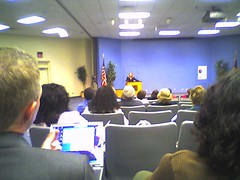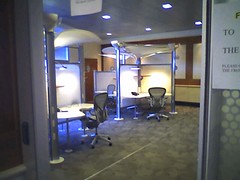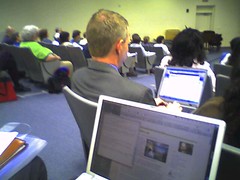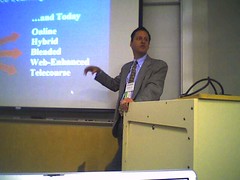[This is moblogged in real time. Please forgive typos and awkward wording]
 I’ve not had the opportunity to hear Susan Patrick before. As someone said as I was setting up, she has a long and very distinguished history. Today she is speaking from her capacity as the President/CEO of the North American Council for Online Learning. The opening session is beginning with a welcome message from the chair of the conference committee. There are people here from all over the state, mostly from community colleges and universities.
I’ve not had the opportunity to hear Susan Patrick before. As someone said as I was setting up, she has a long and very distinguished history. Today she is speaking from her capacity as the President/CEO of the North American Council for Online Learning. The opening session is beginning with a welcome message from the chair of the conference committee. There are people here from all over the state, mostly from community colleges and universities.
I’m paying attention now to the president of the Asheville Community College. I thing that I see, that is counter-intuitive to what you might think, is that the attendees of the conference about teaching online, are a very rich community.
Susan Patrick just asked for a raise of hands by schooling level, and I’m surprised to see that between K-12 and higher ed, the breakdown is about 50-50. Patrick was the lead in writing the National education technology plan, and she traveled to 46 of the 50 states, Mexico, and China. She’s talking about how much technology as changed in her lifetime, from punch cards to calculators (that cost $450). She tells a very compelling story that explains why our children are so get so annoyed by our fascination with how much technology has changed.
Susan Patrick says that what she reshaped our vision of education from the data on how children use the Internet and focus sessions they had with authors of Millennials Rising and other futurist works.
200,000 students from across the U.S. participated in a survey, and it all changed the shape that education should take in the future.
Patrick is promoting distance learning as a solution to many of the problems we are facing in education. We don’t have enough teachers, and we aren’t going to get them. We need to be doing more teaching on line. I won’t say “bah!” This is a conversation that need to be held, and participated in by a log of people.
- Mexico has digitized their entire curriculum and that’s what’s given to their teachers. “They’re thinking systemically.”
- Graduation rate in this country is 70%
- 26% finish 2 years of college
- 80 – 90% of jobs require at least an associates degree.
- IBM created bubble sheets in the 1950s so that they could grade three answers at a time. Where else do we use bubble sheets? (Hmmmm! says a lot)
- In the florida virtual school, online course completion rate is 96%.
- AP pass rates are 60%. For Florida virtual high school, it’s 70%
- more than a third of school districts in the U.S. offer online learning opportunities.
Patrick’s elevator speech is:
- online expands options (high schools offer online course because otherwise they would not be available)
- online learning is grown rapidly (30%/year)
- Online learning is effective (research shows that it is equal or better than face-to-face)
- Online learning improves teaching
You take a teacher who’s been teaching for a few years, if they go through an online learning to teach online, they become a better teacher.
Patrick just said something that I think is very important. Please typically write more in an online learning environment than in face-to-face. This is important, because as people write about what they are learning, they tend to become more fluent in the issues of the topic.
That’s my 2¢ worth.
She says that education is designed to be stable, to change slowly. She says that online learning will power the redesign of education. I’m not going to disagree. I’m rethinking online learning a lot right now.
96% of students believe that education is important for their later life. So why are we losing a third of them before they graduate from high school?
 I’m much more interested in some of the Web 2.0 applications for aggregating content. Some examples include:
I’m much more interested in some of the Web 2.0 applications for aggregating content. Some examples include: 
 DOPA separates our children from their best opportunity to learn the safe use of the Internet — their classrooms. Don’t toss them out in the streets to learn it themselves. This is not a place for our children to learn street smarts.
DOPA separates our children from their best opportunity to learn the safe use of the Internet — their classrooms. Don’t toss them out in the streets to learn it themselves. This is not a place for our children to learn street smarts.




 I believe that I am going to enjoy a unique experience today. I’m speaking at the
I believe that I am going to enjoy a unique experience today. I’m speaking at the